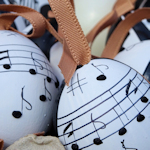
No surprises, here. The main Easter traditions in Austria and Vienna revolve around eggs. Eating them is, of course, one Easter activity, but eggs also form the centrepiece of seasonal arts and crafts.
- Book a concert experience* for the Viennese Easter
- See also:
Decorated eggs
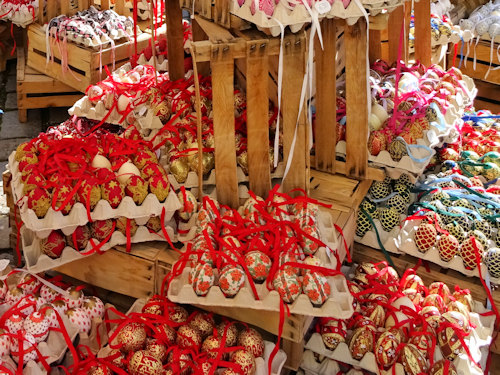
(Egg display at an Easter market)
Decorating eggshells remains a popular tradition that dates back centuries. The egg’s contents are blown out, then the outside painted or otherwise coloured using beads, fabrics or whatever material catches your imagination.
You’ll find plenty of these bright oval delights at Vienna’s Easter markets. The Altwiener Ostermarkt on the Freyung square, for example, normally has a central area brimming with basket after basket of decorated eggs.
Other materials used for egg-shaped decorations include wood or plastic. Polystyrene is popular in Kindergartens. Ah, what artistic wonders the children used to bring home for us to admire (see below).
This is all well and good, but what do you then do with your decorated eggs?
Here’s the answer…
The Easter tree

(In our defence, we had young kids at the time)
In the weeks and days leading up to Easter, Viennese flower shops “blossom” with thin tree branches, mostly of different varieties of willow.
People buy the branches to put in a vase to create the Osterbaum (Easter tree), from which they hang ribbons and decorated eggs.
I’ll be the first to admit that our display (see photo above) won’t be winning an art prize anytime soon, despite its suitability as a metaphor for the chaos of human existence.
Colouring eggs
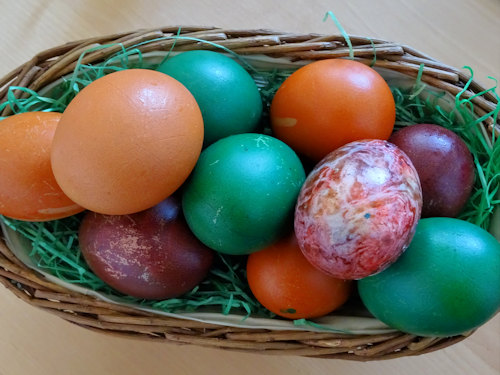
(Ready for action)
The egg-based fun doesn’t stop at decorated versions to hang up: no respectable Easter morning would be seen without a handful of hard-boiled eggs in different colours.
Supermarkets sell ready-coloured eggs, but many people still make their own at home by boiling the eggs in food colouring. If you choose that route yourself, “red” seems to work best.
And what do people do with these eggs (other than eat them)? Hide them, find them, battle with them…
Eiersuchen (egg search)
Young Austrian kids spend many a happy hour on Easter Sunday scouring the garden or apartment for those hard-boiled eggs.
If searching excitedly for hard-boiled eggs sounds a little Dickensian, note that those in charge tend to encourage the hunting instinct by adding chocolate-based alternatives to the hiding places, too.
Eierpecken (egg pecking)
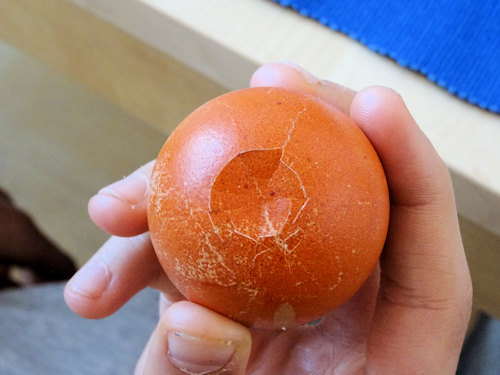
(A veteran of a breakfast encounter)
The eggs also get put to use in a sort of Easter conkers.
Two opponents take hold of an egg each and then “clash eggs” by knocking their ends against each other once. (Yep, the fun never ends at Easter.)
The idea is to crack the opponent’s egg while leaving yours unharmed, allowing you to claim the losing egg for yourself. My family just does it for bragging rights. And, yes, we should get out more.
Strike too hard and you both lose. Too soft and the opponent has the upper hand. It requires considerable skill and nerve to control the speed and timing of the coming together advantageously. (Not really.)
Traditionally, it’s always pointy end against pointy end or flat end against flat end to avoid long, tiresome debates about whether dad’s all-conquering egg performance was tainted by structural manipulation.
The Easter rabbit
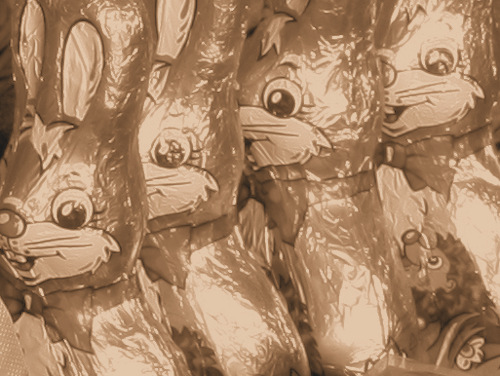
(The rabbit uprising has begun)
And, of course, who brings all these eggs? Why, that famous egg-laying mammal, the Easter rabbit (German: Osterhase – technically an Easter hare).
Chicks, lambs and the like are just supporting characters. The Osterhase is very much the dominant animal.
So while British kids, for example, might delight in a large chocolate egg for Easter, Austrian kids tend to get a large chocolate rabbit.
These typically appear around the meal table, when families might gather for an Easter feast at Sunday lunchtime. Unlike Christmas with its turkey, no particular food springs to mind. Think of Sunday lunch with added chocolate and, perhaps, an appropriately-shaped cake.
Happy Easter!